Abstract
The aim of the study was to evaluate the interconnections between local Schumann resonances of the Earth’s magnetic field and episodes of kidney disease. Materials and Methods: Study participants included 716 males and 624 females who had episodes of kidney disease during the period of 1 January 2021 to 31 December 2021 and attended the Department of Nephrology at the Hospital of Lithuanian University of Health Sciences, Kauno klinikos. Time varying magnetic field data was collected at the magnetometer site located in Lithuania. Results and Conclusions: The study results support the hypothesis that the Earth’s magnetic field has a relationship between the number of nephrology patient hospitalizations per week and the average weekly local Schumann resonances strength in different frequency ranges. Working hypotheses are proposed for the mechanisms of the influence of the Earth’s electromagnetic field on kidney function: а) quantum mechanical features of the atomic composition of renal tissue molecules determine a kidney-specific reaction; b) cyclotron resonance mechanism; c) resonant response of cells of morphological structures of kidney tissue to external bioactive frequencies in the range of 6-8 Hz; d) mechanism of indirect influence of blood as a magnetically saturated medium.
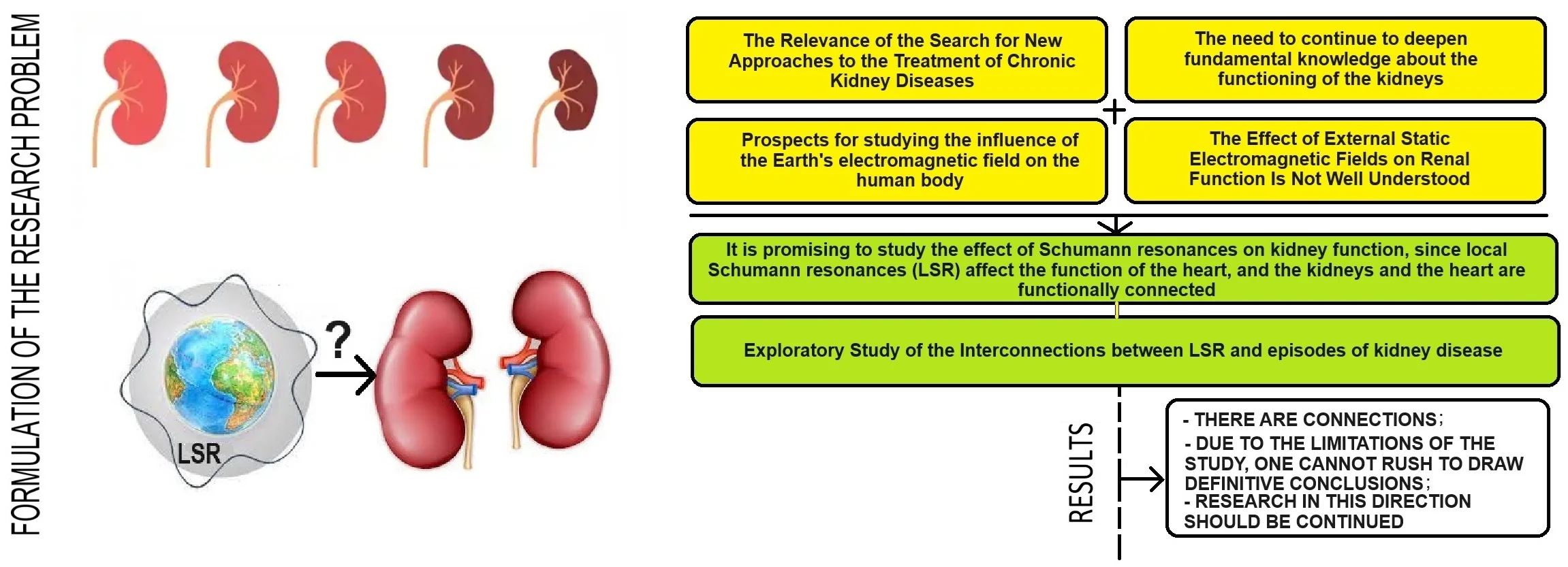
Highlights
- The Relevance of the Search for New Approaches to the Treatment of Chronic Kidney Diseases. The need to continue to deepen fundamental knowledge about the functioning of the kidneys.
- The Effect of External Static Electromagnetic Fields on Renal Function Is Not Well Understood. Prospects for studying the influence of the Earth's electromagnetic field on the human body.
- It is promising to study the effect of Schumann resonances on kidney function, since local Schumann resonances affect the function of the heart, and the kidneys and the heart are functionally connected.
- Exploratory Study of the Interconnections between local Schumann resonances and episodes of kidney disease.
1. Introduction
Chronic kidney disease (CKD) is a major medical and social problem. CKD is wide-spread (diagnosed in 10-13 % of the population, affecting up to 800 million people in the general population), irreversible, progressive and associated with higher cardiovascular risk [1]-[4]. CKD has emerged as one of the most prominent causes of death and suffering in the 21st century. [5] Therefore, it is important for modern medicine to continue to further deepen fundamental knowledge about the functioning of the kidneys in order to develop new approaches to the treatment of kidney diseases and improve existing guidelines.
Thanks to new scientific discoveries, new directions in nephrology can be formed, for example, Quantum Nephrology. This is so because now fundamental science has studied the structure of matter at the micro level (nanolevel and deeper) and the prerequisites for changing the traditional scientific medical paradigm are being formed. According to modern concepts, all matter consists of atoms. Atoms are made up of electrons and pro-tons, which are made up of fermions and bosons. Fermions and bosons are electromagnetic field structures [6]-[9]. It turns out that all matter has an electromagnetic essence of its structure at the nanolevel and deeper. On the one hand, this changes and expands scientific ideas about the role of electromagnetic fields in the functioning of living biological organisms, because they also consist of atoms. On the other hand, extrapolation of this biophysical knowledge to ideas about the structure of the human body opens up new opportunities for further understanding of the fundamental issues of its functioning as a living biological system. Since the human body also consists of atoms, it can be described in the form of a model of a conglomerate of electromagnetic fields (biophysical frequency-wave model of the structure of the human body) when considering it from the position of the micro-level of its structure. The results of scientific research in this new direction of integrating modern biophysical views into medicine were conceptualized in the Magneto-electrochemical Theory of metabolism [9]-[12]. The role of electromagnetic processes in the functioning of cell membranes [9], [13], [14], cellular communication [15] and the role of water [16] was conceptualized. All this once again confirms that the human body consists of electromagnetic energy at the microlevel of the structure of matter and is alive due to the occurrence of electromagnetic processes in it.
Therefore, it is quite logical that the external electromagnetic fields of the Earth can significantly influence the state of the internal magnetic fields of the human body and the functioning of its organs. According to the literature, the influence of the Earth’s external magnetic fields on the human nervous and cardiovascular system has been studied most of all. As it turned out, the frequency ranges of the Earth’s electromagnetic fields, in particular local Schumann resonances, coincide with the frequencies of electrical activity of the brain and can be considered as related synchronized processes [17]-[21]. It has been established that high-frequency waves of Schumann resonances have a stressful effect on living organisms [22]-[25]. The negative impact of the absence of the Earth’s magnetic field on the human body has been proven [26]-[32], etc. The cardioprotective effect of stressful conditions by weak magnetic fields in the Schumann resonance band [33] and subjective and objective improvement in the condition of patients when treating pain and sleep disorders with Schumann resonance frequencies have been established [34,35]. Changes in the Earth’s electromagnetic field are important in the pathogenesis of cardiovascular diseases and they affect the incidence of cardiovascular diseases [36]-[41], etc.
Kidneys are vital organs of the human body, which through the neurocardiometabolic axis are functionally connected with the nervous and cardiovascular systems [42]-[44]. Therefore, it is logical to hypothesize that changes in the Earth’s electromagnetic field should also affect the pathogenesis of kidney disease if they affect the functioning of the nervous and cardiovascular systems. Studies of the influence of changes in the Earth's electromagnetic field on the function of the urinary system have never been carried out in world science before, according to the literature data we have studied. Therefore, the aim of the study was to evaluate the interconnections between local Schumann resonances of the Earth's magnetic field and episodes of kidney disease.
2. Materials and methods
Scientific work is carried out in conjunction with the following scientific institutions: 1) Lithuanian University of Health Sciences (the cooperation coordinator is Head of Nephrology Department, prof., DM I. A. Bumblyte and Senior Researcher of the Laboratory of Automation of Cardiology Research of the Institute of Cardiology of the Lithuanian University of Health Sciences prof., DM A. Vainoras); 2) Poltava State Medical University (the cooperation coordinator is Head of Department of Internal Medicine and Emergency Medicine, prof., DM M. Potyazhenko); 3) HeartMath Institute, USA (the cooperation coordinator is director of research at HeartMath Institute and project coordinator of GCI’s Global Coherence Monitoring System, Ph.D. R. McCarty; 4) Kaunas university of technology, Lithuania, the coordinator of the mathematical part is M. Landaukas, assoc. prof. of the Department of mathematical modelling.
The analysis of the presented data is a subset of research work of the Department of Internal Medicine and Emergency Medicine of Poltava State Medical University (23, Shevchenko St., 36011, Poltava, Ukraine) on “Development of algorithms and technologies for implementing a Healthy Lifestyle in patients with Noncommunicable Diseases based on the study of functional status” (state registration number 0121U108237: UDC 613 616-056-06: 616.1/9-03) and it is a fragment of a research project of the Lithuanian University of Health Sciences on the topic “Investigation of interactions between the Earth’s magnetic field variations and Human and animal health and behavior”).
Hospitalization data at the Nephrology Department of University Hospital at Lithuanian University of Health Sciences and dynamics of local Earth magnetic field Schumann resonances were analyzed in a retrospective exploratory study. The study period was from January 1, 2021 – through December 31, 2021. Admission data for 1340 patients with kidney disease over the period were included in the study. Cases of non-core hospitalizations without kidney pathology were excluded from the analysis. The proportion of emergency hospitalization was 52 % 699/1340 of patients. 53 % 716/1340 of patients were men (mean age is 59.1±17.23 years, Me = 60.80 (18.76; 95.99) years). 47 % 624/1340 of patients were women (mean age is 62.96±17.55 years, Me = 65.2 (18.41; 74.8) years).
The local time varying magnetic field intensity was measured using a local magnetometer situated in Lithuania, which is part of the Global Coherence Monitoring Network. Two magnetic field detectors (Zonge Engineering Inc.) ANT4 are positioned in north/south and east/west orientation. Data used in the analysis is from the East – West direction. Signals from the magnetometers were digitized with a 24-bit data acquisition system (Symmetric Research, Las Vegas NV) at a rate of 130 Hz and uploaded hourly to a cloud data storage site for offline processing. The overview of the magnetometer’s data is available on web page (https://www.heartmath.org/research/global-coherence/gcms-live-data/). Hourly data files were downloaded to a PC workstation for post processing where each hourly data file was transformed into consecutive 30-second-long segments. The power spectral density (PSD) was calculated for each segment. All PSD segments for each hour were then averaged together. The sum of the PSD in the frequency range from 0-65 Hz was calculated for each hour in the study period. In the estimated power curve on the frequency range, from 0 to 65 Hz there is a series of dominant Schumann resonance frequencies, which are divided into ranges that overlap with the EEG wave classification (as related processes): 0 to 3.5 Hz – Delta waves (P1), 3.5 to 7 Hz – Theta waves (P2), 7 to 15 Hz – Alpha waves (P3), 15 to 32 Hz – Beta waves (P4), 32 to 100 Hz – Gamma waves (P5) [46, 47]. Mean power of local magnetic field fluctuations in Lithuania, measured in pT2 s2 in five different frequency ranges which overlaps the Schumann resonance and EEG frequency ranges (we named them as SDelta (0-3,5 Hz), STheta (3,5-7 Hz), SAlpha (7-15 Hz), SBeta (15-32 Hz) and SGamma (32-66 Hz) to distinguish them from the EEG bands). Average readings of Schumann’s local Earth magnetic field dynamics with hospitalization data were compared by calendar weeks of the year.
A spectral analysis of the magnetometer data was made and is summarized below.
Consider magnetic field intensity {It}N-1t=0, where t is discrete time variable:
In order to transform {It}N-1t=0 to the frequency domain the discrete Fourier transform (DFT) (Eq. (1)) was used. The drawback of DFT is that one cannot observe the change in spectral density over time unless sequentially computing DFT. To achieve this the discrete time short time Fourier transform (STFT) was employed:
STFT for {It}N-1t=0 is represented by Eq. (2). In fact this is essentially the analogue for Eq. (1) but applied to the function It⋅ξ(t-τ). ξ(t) is a so called windowing function which has a value close to 1 in a subdomain of t centered on 0 and a value close to 0 elsewhere. The units of f(ω) and F(τ,ω) are pT⋅s due to the fact that the intensity of the magnetic field is measured in pT:
Spectrograms investigated in this work is the squared modulus of STFT (Eq. (3)). Originally units of a spectrogram would be pT2⋅s2. S(τ,ω) is often referenced as power spectral density. Thus, the value of S(τ,ω) is interpreted as signal power at the time interval Δτ starting at the time moment t and at the frequency range Δω correspondingly starting at the frequency ω.
More detailed algebraic and spectral analysis of local magnetic field intensity is presented in [45].
The year was conditionally divided into two semesters in the analysis: from weeks 1 to 25 and from weeks 26 to 52. Fig. 1 shows the number of male and women patients admitted with kidney disease during each week in 2021.
The local Schumann resonances power spectral density over weeks’ period are shown in Fig. 2.
Fig. 1Number of men and women admitted with kidney disease during each week in 2021
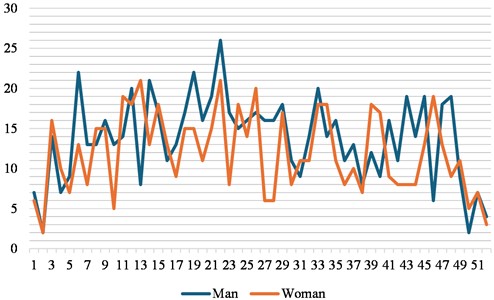
Fig. 2Number of men and women admitted with kidney disease during each week in 2021
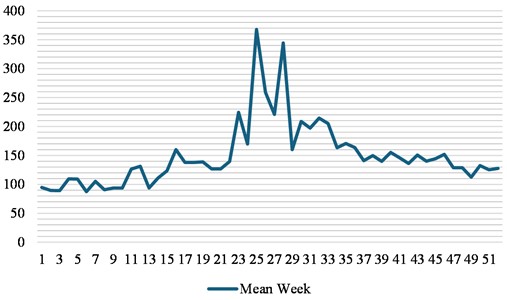
The response of the human body to the Earth’s electromagnetic field may depend on age, so we evaluated the correlation between the age of those hospitalized with episodes of kidney disease and the levels of activity of the local Schumann resonances.
The study was carried out in compliance with all applicable ethical rules.
General scientific methods (dismemberment and integration of elements of the studied system, logical, analysis, induction, deduction and synthesis of knowledge) and theoretical methods (method of constructing theory, logical methods and rules of normative nature) were used in this study. Statistical analysis was performed using the Prism 5.0 software package. The data obtained are presented as mean values with their STDEV (standard deviation of the mean) error (M±STDEV). The differences were considered significant at p< 0.05. Pearson correlation coefficient (rp) and the nonparametric correlation coefficient of Spearman’s ranks (rs). The level of p< 0.05 was considered statistically significant.
3. Results
An analysis of the correlations between the number of hospitalized patients with episodes of kidney disease in 2021 and the levels of activity of the local Schumann resonances has established the existence of a relationship between the local Schumann resonances and the manifestation of nephrological pathology. The fact was established that the annual correlation graphs for men and women had a graphical similarity between the number of kidney disease cases per week and the average weekly local Schumann resonances strength in different frequency ranges (Fig. 3).
Fig. 3Correlation coefficients between number of men and women weekly cases of kidney disease and mean magnetic power in different frequencies for all year 2021
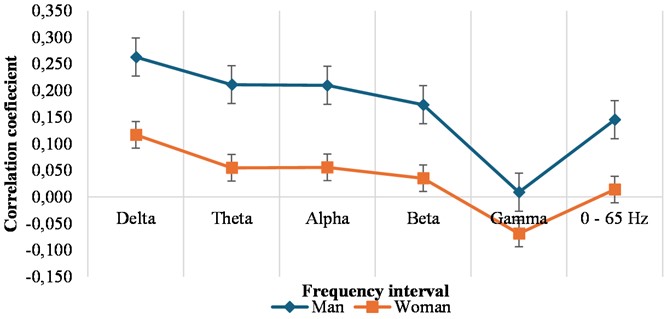
This confirms the presence of a general tendency in nephrological patients of both sexes to respond to changes in the local electromagnetic field of the Earth.
In the female group (N=624) we found single negative correlation coefficient P5 (SGamma) [32;65] Hz (r= –0.069, p= 0.313) (Fig. 3). In other low frequency ranges, we observed positive correlation coefficients: P1 (SDelta) [0;3.5] Hz r= 0.117 (p= 0.204), P2 (STheta) [3.5; 7] Hz r= –0.055 (p= 0.349), P3 (SAlpha) [7;15] Hz r= 0.056 (p= 0.346), P4 (SBeta) [15; 32] Hz r= 0.035 (p= 0.402), P6 [0; 65] Hz r= 0.014 (p= 0.461). All correlations, including all intervals, did not demonstrate significance.
In the male group (N= 716), the weekly correlation coefficients (Fig. 3) are similar to the female group, however, all coefficients are positive: P1 (SDelta) [0; 3.5] Hz, r= 0.263 (p=0.029), P2 (STheta) [3.5; 7] Hz, r= 0.211 (p= 0.066), P3 (SAlpha) [7; 15] Hz, r= 0.210 (p= 0.067), P4 (SBeta) [15; 32] Hz, r= 0.173 (p= 0.11), P5 (SGamma) [32; 65] Hz, r= 0.009 (p= 0.475), P6 [0; 65] Hz, r= 0.145 (p= 0.152).
A higher level of correlation coefficients in men in all ranges may indicate a greater sensitivity of men to the influence of the Earth’s electromagnetic field than women. The low level of correlation coefficients and the lack of significance in a number of indicators can be explained by a limitation of this study: the lack of samples for specific nephrological nosologies. It is logical to assume that for different nosological diagnoses and stages of chronic kidney diseases, different relationships with the influence of the Earth’s electromagnetic field can be established in the future.
Unlike females, we observe non-significant changes in SGamma range, which may indicate slightly different sensitivity of different sexes to the changes of Earth‘s magnetic field. It should be considered that all these frequencies are present at the same time, therefore, the negative SGamma frequency range effect may not outweigh the positive effects of other frequency ranges (SDelta, STheta, SAlpha, SBeta).
After dividing our study period into two halves (weeks 1-26 and weeks 27-52), we found that in the female and male groups, the relationship between the number of kidney disease cases and geomagnetic field strength was different between the two time periods. The indicators in both groups had a general trend and a positive correlation, as shown in Figs. 4 and 5.
Fig. 4Correlation coefficients between number of men and women weekly cases of kidney disease and mean magnetic power in different frequencies for first half of year 2021
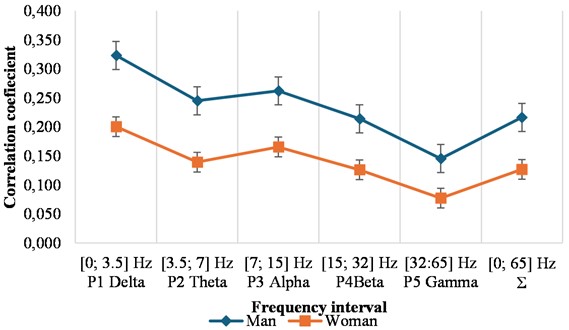
Fig. 5Correlation coefficients between number of men and women weekly cases of kidney disease and mean magnetic power in different frequencies for second half of year 2021
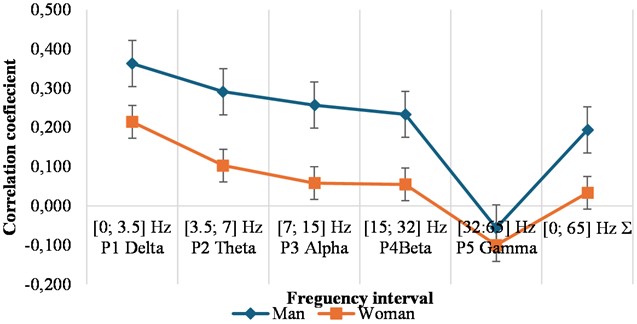
The results of the analysis of correlations by half-year testified in favor of the veracity of the hypothesis of the influence of changes in the local Schumann resonance power of on cases of hospitalization of kidney patients, since the graphical profile of dependencies in women and men was similar in each half-year. According to each half-year, men had higher correlation coefficients. This may indicate their greater sensitivity to changes in the local Schumann resonance, as noted earlier.
In the first half of the year significant positive correlations were observed. There are P1 (SDelta) [0; 3.5] Hz, r= 0.201 (p= 0.16), P2 (STheta) [3.5; 7] Hz, r= 0.140 (p= 0.247), P3 (SAlpha) [7; 15] Hz, r= 0.165 (p= 0.21), P4 (SBeta) [15; 32] Hz, r= 0.126 (p= 0.269), P5 [32; 65] Hz, r= 0.077 (p= 0.35), P6 [0; 65] Hz, r= 0.127 (p= 0.268) in the female group. There are P1 (SDelta) [0; 3.5] Hz, r= 0.323 (p= 0.05), P2 (STheta) [3.5; 7] Hz, r= 0.245 (p= 0.114), P3 (SAlpha) [7; 15] Hz, r= 0.262 (p= 0.098), P4 (SBeta) [15; 32] Hz, r= 0.214 (p= 0.146), P5 [32; 65] Hz, r= 0.146 (p= 0.238), P6 [0; 65] Hz, r= 0.216 (p= 0.145) in the male group (Fig. 4).
In the second half of the year, only the P5 [32; 65] Hz range was negative correlated in all groups: in the female group correlation coefficients is r= –0.1 (p= 0.686) and in the male group correlation coefficients is r= –0.056 (p= 0.601). In other frequency ranges stronger and significant positive correlations were observed. There are P1 (SDelta) [0; 3.5] Hz, r= 0.214 (p= 0.146), P2 (STheta) [3.5; 7] Hz, r= 0.103 (p= 0.308), P3 (SAlpha) [7; 15] Hz, r= 0.58 (p= 0.009), P4 (SBeta) [15; 32] Hz, r= 0.55 (p= 0.005), P6 [0; 65] Hz, r= 0.33 (p= 0.049) in the female group. There are P1 (SDelta) [0; 3.5] Hz, r= 0.363 (p= 0.034), P2 (STheta) [3.5; 7] Hz, r= 0.291 (p= 0.074), P3 (SAlpha) [7; 15] Hz, r= 0.257 (p= 0.102), P4 (SBeta) [15; 32] Hz, r= 0.233 (p= 0.126), P6 [0; 65] Hz, r= 0.193 (p= 0.117) in the male group (Fig. 5).
Correlations between the age of those hospitalized with episodes of kidney disease and the levels of activity of the Earth's electromagnetic field were established in the study (Fig. 6).
Fig. 6Correlation coefficients between age of men and women weekly cases of kidney disease and mean magnetic power in different frequencies for all year 2021
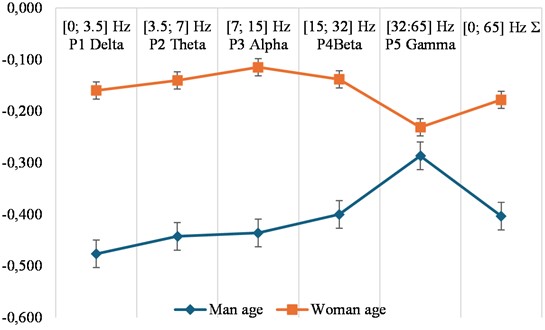
A significant negative correlation was established in the female group and in the male group, but in the male group it was strong. There are P1 (SDelta) [0; 3.5] Hz, r= –0.160 (p= 0.128), P2 (STheta) [3.5; 7] Hz, r= –0.140 (p= 0.161), P3 (SAlpha) [7; 15] Hz, r= –0.115 (p= 0.208), P4 (SBeta) [15; 32] Hz, r= –0.138 (p= 0.164), P5 [32; 65 Hz], r= –0.231 (p= 0.049), P6 [0; 65] Hz, r= –0.178 (p= 0.103) in the female group. There are P1 (SDelta) [0; 3.5] Hz, r= –0.476 (p= 0.0001), P2 (STheta) [3.5; 7] Hz, r= –0.442 (p= 0.0005), P3 (SAlpha) [7; 15] Hz, r= –0.436 (p= 0.0006), P4 (SBeta) [15; 32] Hz, r= –0.400 (p= 0.001), P5 [32; 65] Hz, r= –0.287 (p= 0.019), P6 [0; 65] Hz, r= –0.403 (p= 0.001) in the male group (Fig. 6).
After dividing our study period into two halves (weeks 1-26 and weeks 27-52), we found that in the female and male groups, the relationship between the age of the patients with kidney disease cases and geomagnetic field strength was different between the two time periods. Differences in the correlation indicators of age and mean magnetic power in different frequencies in the groups had a general trend of difference between men and women (p<0.05), as shown in Figs. 7 and 8.
In the first half and in the second half of the year, weak negative relationships were established in the female group, which had a general trend of similarity between themselves in half-years in terms of the strength of the correlation (Figs. 7 and 8). In the first half of the year, the only positive correlation coefficient P1 (SDelta) [0; 3.5] Hz, r= 0.0154 (p= 0,47) was found, which had a very weak correlation strength. There are, P2 (STheta) [3.5; 7] Hz, r= –0.002 (p= 0.496), P3 (SAlpha) [7; 15] Hz, r= –0.016 (p=0.469), P4 (SBeta) [15; 32] Hz, r= –0.015 (p= 0.471), P5 [32;65] Hz, r= –0.047 (p=0.409), P6 [0; 65] Hz, r= –0.023 (p= 0.455) in the female group in the first half of the year (Fig. 7). There are P1 (SDelta) [0; 3.5] Hz, r= –0.094 (p= 0.324), P2 (STheta) [3.5; 7] Hz, r= –0.073 (p= 0.362), P3 (SAlpha) [7; 15] Hz, r= –0.012 (p= 0.477), P4 (SBeta) [15; 32] Hz, r= –0.075 (p= 0.358), P5 [32; 65 Hz], r= –0.209 (p= 0.153), P6 [0; 65] Hz, r= –0.122 (p= 0.276) in the female group in the second half of the year (Fig. 8). All correlations, including all intervals, did not demonstrate significance.
Fig. 7Correlation coefficients between age of men and women weekly cases of kidney disease and mean magnetic power in different frequencies for first half of year 2021
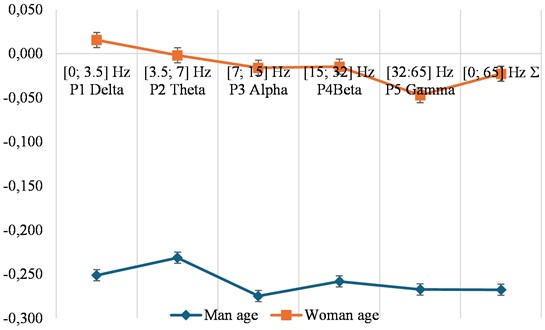
Fig. 8Correlation coefficients between age of men and women weekly cases of kidney disease and mean magnetic power in different frequencies for second half of year 2021
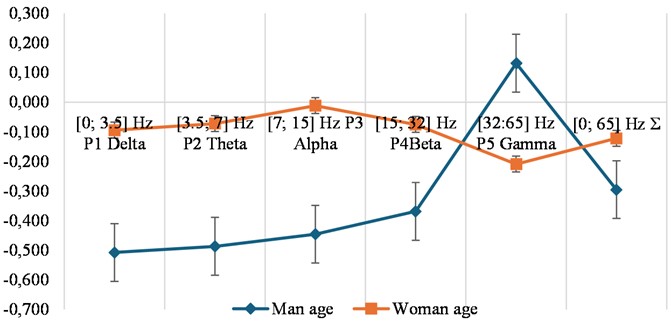
In the first half and in the second half of the year significant negative correlations were observed in the male group, which differed from each other in half-years in terms of the strength of the correlation (Figs. 7 and 8). There are P1 (SDelta) [0; 3.5] Hz, r= –0.251 (p= 0.108), P2 (STheta) [3.5; 7] Hz, r= –0.231 (p= 0.128), P3 (SAlpha) [7; 15] Hz, r= –0.275 (p= 0.086), P4 (SBeta) [15; 32] Hz, r= –0.258 (p= 0.101), P5 [32; 65] Hz, r= –0.267 (p= 0.093), P6 [0; 65] Hz, r= –0.268 (p= 0.092) in the male group in the first half of the year (Fig. 7). There are P1 (SDelta) [0; 3.5] Hz, r= –0.507 (p= 0.004), P2 (STheta) [3.5; 7] Hz, r= –0.487 (p= 0.005), P3 (SAlpha) [7; 15] Hz, r= –0.446 (p=0.011), P4 (SBeta) [15; 32] Hz, r= –0.369 (p= 0.031), P6 [0; 65] Hz, r= –0.295 (p= 0.071) in the male group in the second half of the year (Fig. 8). Not significant positive correlation coefficient P5 (SGamma) [32; 65] Hz r= 0.131 (p= 0.261) found in the male group in the second half of the year.
4. Discussion
What are the mechanisms of influence of external electromagnetic fields on kidney function? This issue has not been studied in detail in the medical science available to us. Therefore, we propose to discuss possible mechanisms of influence on the basis of known fundamental knowledge, guided by the methodology of theoretical research.
The impact exerted by the Earth's external electromagnetic fields can manifest itself at all hierarchical levels of the structural organization of the urinary system of the human body: it can be at the organismal level, at the organ level, at the levels of tissues and molecules, at the atomic level and at the subatomic level (nanolevel and deeper). The most interesting aspects are the micro-level effects of electromagnetic fields, since they are basic for understanding the essence of metabolic processes and are not sufficiently integrated into medicine.
At the micro level of structural organization, kidneys are made up of molecules, which are made up of atoms. The electrons and nuclei of the atoms of the kidney tissue molecules are under the constant influence of the internal electromagnetic fields of the body (for example, the electromagnetic fields of cell membranes, etc.) and under the influence of external electromagnetic fields (for example, the local electromagnetic field of the Earth, etc.). In this case, changes in electromagnetic fields affect the energy parameters of electrons and the movement of electrons, changing the angular velocity of its rotation in orbit. An atom of each substance has individual quantum mechanical characteristics and therefore each atom is characterized by its own physical feature of changing the magnetic moments of electrons and atomic nuclei when interacting with an external magnetic field. Atoms of different chemical elements react differently to changes in the electromagnetic field, depending on which class of magnets they belong to. There are three classes of atoms of chemical elements or substances consisting of them: they are diamagnetic, paramagnetic and ferromagnetic [46-49]. It is well known that 99 % of the molecules of the human body consist of a combination of chemical elements such as carbon (C), hydrogen (H), oxygen (O), nitrogen (N). Of these, 60 % is hydrogen (H), which probably plays an important role in the response to changes in external electromagnetic fields. Hydrogen (H) and carbon (C) are diamagnetic and are magnetized against an external magnetic field. Diamagnets include silicon (Si), phosphorus (P), sulfur (S), chlorine (Cl), copper (Cu), iodine (J), bromine (Br). Oxygen (O), sodium (Na), magnesium (Mg), potassium (K), calcium (Ca) are paramagnetic and are magnetized in an external magnetic field in the direction of the field [50]-[53]. The unique atomic composition of the molecules of human kidney tissue determines the formation of a specific quantum-mechanical energy state of kidney cells at the micro level, since with an increase in the strength of the external magnetic field, the oppositely directed magnetic moments of elements related to diamagnetic and paramagnetic materials will increase. This will lead to an increase in the precessional effect of vibrations of the electron orbits of individual atoms. It is important to note that the morphological structure of kidney tissue changes with a person’s age [54], [55] and with the progression of pathology [56], [57]. Therefore, it is quite logical that during the aging process and with the progression of chronic kidney diseases, the content of various molecules in the composition of kidney tissue cells and the content of various elements in these molecules change. Differences in the qualitative and quantitative composition of atoms of chemical elements in the kidney tissues of young healthy people and patients with chronic kidney diseases may cause their different reactions to changes in local electromagnetic fields. This is one of the new hypotheses, which is promising for further research in the new emerging medical field “magnetonephrology”.
Many biochemical ion exchange reactions occur in the kidneys. For example, exchange processes of hydrogen ions (H+), potassium (K+), sodium (Na+), calcium (Ca2+), magnesium (Mg2+), chlorine (Cl-), sulfates, etc. occur [58], [59]. When considered from the standpoint of quantum physics, all ions are electromagnetic field structures at the microlevel of their structure. At the same time, they are more reactive than atoms, since some of their electrons are taken away. Therefore, ions are more sensitive to the effects of changes in electromagnetic fields and respond to related frequencies from the environment. Under the influence of changes in electromagnetic fields, the quantum mechanical characteristics of ions change and the oscillatory processes in them intensify - they behave like isotropic oscillators carrying a charge.
This mechanism of ion response to changes in the electromagnetic field is described in the scientific literature as cyclotron resonance. It is believed that cyclotron resonance is one of the electromagnetic mechanisms for regulating the rate of biochemical reactions in the cells of biological systems [60]-[67]. Therefore, it is quite logical that a change in the local electromagnetic field of the Earth through the mechanism of cyclotron resonance of ions can affect the functional state of nephrons and the functioning of the kidneys. This is the second working hypothesis. It is necessary to initiate further research to clearly understand the influence of the Earth's electromagnetic field on water-electrolyte metabolism.
As has been repeatedly noted, the bodies of all living organisms and humans are formed from atoms. The nucleus of every atom has a charge and is constantly rotating. Each type of atom of a substance is characterized by its own specific constant frequency of rotation of the nucleus - precession of the nucleus. It is thanks to the knowledge of the precession frequencies of nuclei that science has been able to establish the elementary composition of the human body. Knowing the frequency of precession of atomic nuclei, one can reliably establish the presence of certain substances, types of cells and tissues, processes in the human body. Nuclear precession is an objective constant physical parameter for the atoms of each substance, which can be established as follows: it is necessary to irradiate the nuclei of atoms with radio waves, constantly changing the frequency until it coincides with the precession frequency of the nuclei - a resonance will arise, which will be recorded by a measuring device [68]-[71]. This principle has made it possible to scientifically establish the frequency properties of most recognizable microbes, chemicals, tissues, and the functioning of the organs of the human body. It is also widely used to study the structural organization of the human body in the well-known technique of Nuclear Magnetic Resonance [70], [71]. In 1952, Felix Bloch and Edward Mills Purcell (USA) received the Nobel Prize in Physics for the discovery of the phenomenon of nuclear magnetic resonance. [72]. In 2003, Paul C. Lauterbur (USA) and Sir Peter Mansfield (UK) received the Nobel Prize in Physiology or Medicine for the development of the diagnostic method of magnetic resonance imaging [73]. Thus, according to modern scientific views, substances (microelements, vitamins, hormones, etc.), types of cells and tissues (microorganisms, cancer cells, etc.), metabolic processes in the human body can be verified by the total frequency component own metabolic processes in them using special diagnostic equipment that makes it possible to record the phenomenon of resonance [71], [74]. When studying resonant infrasonic waves of the human body, it was found that the operating frequency range for the kidneys is 6-8 Hz [75], [76]. Such frequencies exist in local Schumann resonances. They can also have a resonant effect on kidney function, since when the frequencies of kidney functioning and local Schumann resonances coincide, the vibration of the corresponding molecular-cellular structures of kidney tissue increases, which can have a clinical effect. But this requires further research in the field of magnetic physiology of the kidneys.
Blood is a magnetically saturated medium capable of exhibiting properties inherent in magnets. The kidneys are an organ that is actively supplied with blood. It is well known that in an adult healthy person, about 25 % of the cardiac blood output per minute passes through the kidneys - 1000-1400 ml/min. The kidneys have a relatively small mass of about 150-200 g and mathematical calculations show that the circulatory load on them is approximately 4-5 times greater than on the heart and brain [59]. Therefore, we must take into account the magnetic properties of blood when we consider possible mechanisms of the kidneys' response to changes in the local electromagnetic fields of the Earth. Science has established that an external magnetic field can have the greatest influence on the state of the human body through the ferromagnet iron. Iron atoms have a non-zero magnetic moment. In the body, iron is concentrated in the blood. Up to 60 % of blood iron is found in the iron-containing blood protein - hemoglobin. Therefore, the local electromagnetic field of the Earth can have an effect on the blood by changing the distribution of ions and their transport through the human erythrocyte membrane. This leads to a change in the electrical potential of erythrocytes and changes the processes of depolarization of membranes and in their structures. In erythrocytes whose membranes were exposed to an electromagnetic field, changes in the transfer of electrogenic sodium and potassium ions, a decrease in electrical mobility, an increase in membrane permeability and activation of their aggregation properties were observed. Spontaneous magnetization of an array of particles can lead to the appearance of groups with an ordered packing of particles due to the parallel orientation of their magnetic moments. Moving in the vascular bed, such a group represents a soliton-like object [77]-[79]. Since as an object moves due to a change, for example, in the lumen of the vascular bed, its magnetic flux inevitably changes, then, in accordance with the law of electromagnetic induction, electric currents will arise, seeking to compensate for changes in the magnetic flux. Because blood plasma contains a large number of ions, it is electrically conductive. Electric currents induced by moving objects can cause increased plasma circulation around them, and, consequently, around each red blood cell. Since the kidneys are an organ whose functions are closely related to the blood flow, this mechanism can also influence their general electromagnetic state and response to influence.
Ferromagnetism is another additional biophysical mechanism for sensory transduction of human magnetoreception. The literature describes the mechanism of direct interaction of external electromagnetic fields with nanocrystals of ferrimagnetic minerals of human cells, for example, with magnetite (Fe3O4). In the human body, biogenic magnetite is found in the tissues of the brain, heart, liver, spleen, adrenal glands, ethmoid bone, as well as in pathologically altered tissues due to cancer and atherosclerosis [80]-[84]. Biogenic magnetite is of biogenic origin and is gradually formed as a result of crystallization directly in the cells of the body. The presence of magnetite in living cells of the body is considered one of the possible reasons for their sensitivity to the local electromagnetic field of the Earth [85]-[88]. However, data on the presence of magnetite in kidney tissues were not found in the scientific literature. This casts doubt on the implementation of this mechanism in the response of the kidneys to changes in the local electromagnetic field of the Earth.
Thus, Fig. 9 presents working hypotheses explaining the possible mechanisms of the kidneys’ response to changes in the local geomagnetic field of the Earth.
Fig. 9Working hypotheses explaining possible mechanisms of kidney response to changes in the local geomagnetic field of the Earth
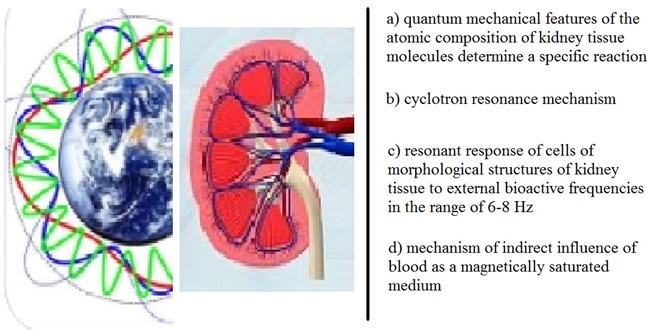
5. Limitations of the study
This study has several limitations. The study did not evaluate the effect on specific nosological forms of kidney disease, since the study was performed as an exploratory study. The study did not evaluate solar activity or other weather conditions that could have an additional effect beyond changes in the local geomagnetic field.
6. Conclusions
1) It has been established that there is a connection between changes in the local electromagnetic field of the Earth and the manifestation of nephrological pathology in nephrological patients of both sexes.
2) It can be assumed that the Earth's electromagnetic field in the high-frequency range of the local geomagnetic field has a positive effect on the pathogenetic mechanisms of kidney pathology: SGamma [32; 65] Hz is r=0.009 in the male group and it’s r= –0.069 in the female group).
3) Reliable gender differences in correlations between the influence of changes in the Earth's electromagnetic field on the functional state of the kidneys were not established when analyzing studies.
4) More powerful Electromagnetic power of Schuman resonances are negatively correlated with patients mean age in men – higher field power, more young person’s became ill with kidney diseases. This support that EMF in Schuman resonances provoke kidney diseases in men.
5) The following are presented as working hypotheses explaining the possible mechanisms of the kidneys’ response to changes in the local geomagnetic field of the Earth: а) quantum mechanical features of the atomic composition of renal tissue molecules determine a kidney-specific reaction; b) cyclotron resonance mechanism; c) resonant response of cells of morphological structures of kidney tissue to external bioactive frequencies in the range of 6-8 Hz; d) mechanism of indirect influence of blood as a magnetically saturated medium.
References
-
A. L. Ammirati, “Chronic kidney disease,” Revista da Associação Médica Brasileira, Vol. 66, No. suppl 1, pp. s03–s09, Jan. 2020, https://doi.org/10.1590/1806-9282.66.s1.3
-
B. Dąbek et al., “Novel therapeutic approaches in the management of chronic kidney disease,” Biomedicines, Vol. 11, No. 10, p. 2746, Oct. 2023, https://doi.org/10.3390/biomedicines11102746
-
C. Charles and A. H. Ferris, “Chronic kidney disease,” Primary Care: Clinics in Office Practice, Vol. 47, No. 4, pp. 585–595, Dec. 2020, https://doi.org/10.1016/j.pop.2020.08.001
-
K. Kalantar-Zadeh, T. H. Jafar, D. Nitsch, B. L. Neuen, and V. Perkovic, “Chronic kidney disease,” The Lancet, Vol. 398, No. 10302, pp. 786–802, Aug. 2021, https://doi.org/10.1016/s0140-6736(21)00519-5
-
C. P. Kovesdy, “Epidemiology of chronic kidney disease: an update 2022,” Kidney International Supplements, Vol. 12, No. 1, pp. 7–11, Apr. 2022, https://doi.org/10.1016/j.kisu.2021.11.003
-
J. D. Wells, SpringerBriefs in Physics. Cham: Springer International Publishing, 2020, https://doi.org/10.1007/978-3-030-38204-9
-
T. Hübsch, Advanced Concepts in Particle and Field Theory. Cambridge University Press, 2023.
-
O. P. Minser, M. M. Potyazhenko, and G. V. Nevoit, Magnetoelectrochemical Theory of Metabolism. Volume 1 Conceptualization. Ukraine: Interservice, 2021.
-
O. P. Minser, M. M. Potiazhenko, and G. V. Nevoit, “Evaluation of the human bioelectromagnetic field in medicine: the development of methodology and prospects are at the present scientific stage,” Wiadomości Lekarskie, Vol. 72, No. 5, pp. 1117–1121, Jan. 2019, https://doi.org/10.36740/wlek201905231
-
O. P. Mintser, M. Potiazhenko, A. L. Vainoras, I. B. Bumblytė, and G. V. Nevoit, “Informational Analytical Representations of the Magneto-Electrochemical Theory of Metabolism, Life and Health,” Ukraïnsʹkij Žurnal Medicini, Bìologìï Ta Sportu, Vol. 7, No. 5, pp. 232–246, Nov. 2022, https://doi.org/10.26693/jmbs07.05.232
-
G. V. Nevoit, “Magnetoelectrochemical concept of metabolism: postulates and main conclusions. Part 1,” Current issues of modern medicine: Bulletin of the Ukrainian Medical Dental Academy, Vol. 21, No. 1, pp. 203–209, Mar. 2021, https://doi.org/10.31718/2077-1096.21.1.203
-
O. Mintser, M. Potiazhenko, and G. Nevoit, “Informational analytical representations of the magneto-electrochemical theory of life and health,” Journal of Applied Interdisciplinary Research, Vol. 2, pp. 91–98, 2023.
-
O. P. Mintser, V. V. Semenets, M. Potiazhenko, P. Podpruzhnykov, and G. V. Nevoit, “The study of the electromagnetic component of the human body as a diagnostic indicator in the examination of patients with non-communicable diseases: problem statement,” Wiadomości Lekarskie, Vol. 73, No. 6, pp. 1279–1283, Jan. 2020, https://doi.org/10.36740/wlek202006139
-
G. Nevoit, I. A. Bumblyte, M. Potyazhenko, and O. Minser, “Modern biophysical view of electromagnetic processes of the phenomenon of life of living biological systems as a promising basis for the development of complex medicine: the role of cell membranes,” Journal of Complexity in Health Sciences, Vol. 5, No. 1, pp. 22–34, Jun. 2022, https://doi.org/10.21595/chs.2022.22787
-
G. Nevoit, I. A. Bumblyte, M. Potyazhenko, O. Minser, and A. Vainoras, “Modern biophysical view of electromagnetic processes of the phenomenon of life of living biological systems as a promising basis for the development of complex medicine: the role of biophotons,” Journal of Complexity in Health Sciences, Vol. 6, No. 1, pp. 1–15, Jun. 2023, https://doi.org/10.21595/chs.2023.23443
-
G. Nevoit, I. A. Bumblyte, M. Potyazhenko, and O. Minser, “Modern biophysical view of electromagnetic processes of the phenomenon of life of living biological systems as a promising basis for the development of complex medicine: the role of water,” Journal of Complexity in Health Sciences, Vol. 5, No. 2, pp. 45–57, Dec. 2022, https://doi.org/10.21595/chs.2022.23089
-
R. McCraty, M. Atkinson, V. Stolc, A. A. Alabdulgader, A. Vainoras, and M. Ragulskis, “Synchronization of human autonomic nervous system rhythms with geomagnetic activity in human subjects,” International Journal of Environmental Research and Public Health, Vol. 7, No. 14, p. 770, 2017.
-
A. L. Fred et al., “A brief introduction to magnetoencephalography (MEG) and its clinical applications,” Brain Sciences, Vol. 12, No. 6, p. 788, Jun. 2022, https://doi.org/10.3390/brainsci12060788
-
B. J. Roth, “Biomagnetism: the first sixty years,” Sensors, Vol. 23, No. 9, p. 4218, Apr. 2023, https://doi.org/10.3390/s23094218
-
M. C. M. B. Valente et al., “Electroencephalographic study of gamma rhythm in the autobiographical memory evocation mediated by musical stimuli,” World Journal of Neuroscience, Vol. 9, No. 3, pp. 199–207, Jan. 2019, https://doi.org/10.4236/wjns.2019.93013
-
S. Ueno, “Studies on magnetism and bioelectromagnetics for 45 years: from magnetic analog memory to human brain stimulation and imaging,” Bioelectromagnetics, Vol. 33, No. 1, pp. 3–22, Oct. 2011, https://doi.org/10.1002/bem.20714
-
S. Ray and J. H. R. Maunsell, “Differences in gamma frequencies across visual cortex restrict their possible use in computation,” Neuron, Vol. 67, No. 5, pp. 885–896, Sep. 2010, https://doi.org/10.1016/j.neuron.2010.08.004
-
X. Jia and A. Kohn, “Gamma rhythms in the brain,” PLoS Biology, Vol. 9, No. 4, p. e1001045, Apr. 2011, https://doi.org/10.1371/journal.pbio.1001045
-
C. L. Zilli Vieira et al., “Geomagnetic disturbances reduce heart rate variability in the normative aging study,” Science of The Total Environment, Vol. 839, p. 156235, Sep. 2022, https://doi.org/10.1016/j.scitotenv.2022.156235
-
A. Alabdulgader et al., “Long-term study of heart rate variability responses to changes in the solar and geomagnetic environment,” Scientific Reports, Vol. 1, No. 8, 2018.
-
V. N. Binhi and F. S. Prato, “Biological effects of the hypomagnetic field: an analytic review of experiments and theories,” PLoS One, Vol. 12, p. e0179340, 2017, https://doi.org/10.1071/journal.pone.0179340
-
Y. I. Gurfinkel, O. Y. At’Kov, A. L. Vasin, T. K. Breus, M. L. Sasonko, and R. Y. Pishchalnikov, “Effect of zero magnetic field on cardiovascular system and microcirculation,” Life Sciences in Space Research, Vol. 8, pp. 1–7, Feb. 2016, https://doi.org/10.1016/j.lssr.2015.11.001
-
D. A. Hart, “Homo sapiens-a species not designed for space flight: health risks in low earth orbit and beyond, including potential risks when traveling beyond the geomagnetic field of earth,” Life, Vol. 13, No. 3, p. 757, Mar. 2023, https://doi.org/10.3390/life13030757
-
W. Erdmann, H. Kmita, J. Z. Kosicki, and Kaczmarek, “How the geomagnetic field influences life on earth – an integrated approach to geomagnetobiology,” Origins of Life and Evolution of Biospheres, Vol. 51, No. 3, pp. 231–257, Aug. 2021, https://doi.org/10.1007/s11084-021-09612-5
-
X. Xue et al., “Geomagnetic shielding enhances radiation resistance by promoting DNA repair process in human bronchial epithelial cells,” International Journal of Molecular Sciences, Vol. 21, No. 23, p. 9304, Dec. 2020, https://doi.org/10.3390/ijms21239304
-
V. N. Binhi and A. B. Rubin, “Theoretical concepts in magnetobiology after 40 years of research,” Cells, Vol. 11, No. 2, p. 274, Jan. 2022, https://doi.org/10.3390/cells11020274
-
J. Martel, S.-H. Chang, G. Chevalier, D. M. Ojcius, and J. D. Young, “Influence of electromagnetic fields on the circadian rhythm: implications for human health and disease,” Biomedical Journal, Vol. 46, No. 1, pp. 48–59, Feb. 2023, https://doi.org/10.1016/j.bj.2023.01.003
-
G. Elhalel, C. Price, D. Fixler, and A. Shainberg, “Cardioprotection from stress conditions by weak magnetic fields in the Schumann Resonance band,” Scientific Reports, Vol. 9, No. 1, p. 1645, Feb. 2019, https://doi.org/10.1038/s41598-018-36341-z
-
Y.-S. Huang et al., “The subjective and objective improvement of non-invasive treatment of Schumann resonance in insomnia-a randomized and double-blinded study,” Nature and Science of Sleep, Vol. 14, pp. 1113–1124, Jun. 2022, https://doi.org/10.2147/nss.s346941
-
Y. Fan, X. Ji, L. Zhang, and X. Zhang, “The analgesic effects of static magnetic fields,” Bioelectromagnetics, Vol. 42, No. 2, pp. 115–127, Jan. 2021, https://doi.org/10.1002/bem.22323
-
A. Alabdulgader et al., “Human heart rhythm sensitivity to earth local magnetic field fluctuations,” Journal of Vibroengineering, Vol. 6, No. 17, pp. 3271–3278, 2015.
-
I. Timofejeva et al., “Identification of a group’s physiological synchronization with earth’s magnetic field,” International Journal of Environmental Research and Public Health, Vol. 14, No. 9, p. 998, Sep. 2017, https://doi.org/10.3390/ijerph14090998
-
G. Taletaviciene, R. McCraty, V. Pestininkas, and A. Vainoras, “Investigation of parallels between human basal metabolic features and local Earth magnetic field,” Journal of Complexity in Health Sciences, Vol. 4, No. 1, pp. 31–37, Jun. 2021, https://doi.org/10.21595/chs.2021.22123
-
G. Taletaviciene, R. McCraty, N. W. Qammar, M. Ragulskis, and A. Vainoras, “Correlations between basal metabolic rate in humans with different age, gender, BMI and local earth magnetic field activity,” Journal of Complexity in Health Sciences, Vol. 4, No. 2, pp. 55–62, Dec. 2021, https://doi.org/10.21595/chs.2021.22345
-
N. W. Qammar et al., “Long observation window reveals the relationship between the local earth magnetic field and acute myocardial infarction,” Atmosphere, Vol. 14, No. 8, p. 1234, Jul. 2023, https://doi.org/10.3390/atmos14081234
-
V. Smalinskas, A. Vainoras, G. Ziubryte, G. Jarusevicius, M. K. Ragulskis, and R. McCraty, “Investigation of 5-year interconnections between local Earth magnetic field fluctuations and acute myocardial infarction in Lithuania,” Asian Review of Environmental and Earth Sciences, Vol. 9, No. 1, pp. 1–8, Mar. 2022, https://doi.org/10.20448/arees.v9i1.3786
-
J. Shirani, S. Meera, and V. Dilsizian, “The cardiorenal axis: myocardial perfusion, metabolism, and innervation,” Current Cardiology Reports, Vol. 21, No. 7, p. 60, May 2019, https://doi.org/10.1007/s11886-019-1147-3
-
M. Marassi and G. P. Fadini, “The cardio-renal-metabolic connection: a review of the evidence,” Cardiovascular Diabetology, Vol. 22, No. 1, p. 195, Jul. 2023, https://doi.org/10.1186/s12933-023-01937-x
-
J. Rangaswami, K. Tuttle, and M. Vaduganathan, “Cardio-renal-metabolic care models,” Circulation: Cardiovascular Quality and Outcomes, Vol. 13, No. 11, Nov. 2020, https://doi.org/10.1161/circoutcomes.120.007264
-
M. Landauskas, A. Vainoras, and M. Ragulskis, “Algebraicandspectralanalysisof localmagnetic fieldintensity,” Proceding of the Lithuanian Mathematical Society, Ser. A, Vol. 56, pp. 54–59, 2015.
-
A. H. Boozer, “Perturbation to the magnetic field strength,” Physics of Plasmas, Vol. 13, No. 4, p. 04450, Apr. 2006, https://doi.org/10.1063/1.2192511
-
É. Du Trémolet de Lacheisserie, D. Gignoux, and M. Schlenker, Magnetism. Boston, MA: Springer US, 2002, https://doi.org/10.1007/978-1-4615-1129-8
-
D. Jiles, Introduction to Magnetism and Magnetic Materials. Boca Raton, USA: CRC Press, 2015, https://doi.org/10.1201/b18948/introduction-magnetism-magnetic-materials-david-jiles
-
P. Tipler and G. Mosca, Physics for Scientists and Engineers: Electricity, Magnetism, Light, and Elementary Modern Physics. USA: W.H. Freeman, 2003.
-
M. Gaeta et al., “Magnetism of materials: theory and practice in magnetic resonance imaging,” Insights into Imaging, Vol. 12, No. 1, p. 179, Dec. 2021, https://doi.org/10.1186/s13244-021-01125-z
-
V. Zablotskii, T. Polyakova, and A. Dejneka, “Effects of high magnetic fields on the diffusion of biologically active molecules,” Cells, Vol. 11, No. 1, p. 81, Dec. 2021, https://doi.org/10.3390/cells11010081
-
S. Kwon et al., “Magnetotactic molecular architectures from self-assembly of β-peptide foldamers,” Nature Communications, Vol. 6, No. 1, p. 8747, Oct. 2015, https://doi.org/10.1038/ncomms9747
-
A. Forssén, “Inorganic elements in the human body. I. Occurrence of Ba, Br, Ca, Cd, Cs, Cu, K, Mn, Ni, Sn, Sr, Y and Zn in the human body,” Annales Medicinae Experimentalis et Biologiae Fenniae, Vol. 50, No. 3, pp. 99–162, 1972.
-
J. Dybiec, M. Szlagor, E. Młynarska, J. Rysz, and B. Franczyk, “Structural and functional changes in aging kidneys,” International Journal of Molecular Sciences, Vol. 23, No. 23, p. 15435, Dec. 2022, https://doi.org/10.3390/ijms232315435
-
Y. Fang, A. Y. Gong, S. T. Haller, L. D. Dworkin, Z. Liu, and R. Gong, “The ageing kidney: molecular mechanisms and clinical implications,” Ageing Research Reviews, Vol. 63, p. 101151, Nov. 2020, https://doi.org/10.1016/j.arr.2020.101151
-
J. Wijkström et al., “Clinical findings and kidney morphology in chronic kidney disease of unknown cause in India,” Journal of Internal Medicine, Vol. 294, No. 4, pp. 492–505, Jul. 2023, https://doi.org/10.1111/joim.13690
-
F. Degrassi, E. Quaia, P. Martingano, M. Cavallaro, and M. A. Cova, “Imaging of haemodialysis: renal and extrarenal findings,” Insights into Imaging, Vol. 6, No. 3, pp. 309–321, Feb. 2015, https://doi.org/10.1007/s13244-015-0383-3
-
P. H. Imenez Silva and N. Mohebbi, “Kidney metabolism and acid-base control: back to the basics,” Pflügers Archiv – European Journal of Physiology, Vol. 474, No. 8, pp. 919–934, May 2022, https://doi.org/10.1007/s00424-022-02696-6
-
H. Dominiczak and M. Szczepaimageska-Konkel, “Chapter 23 role of kidneys in metabolism,” in Medical Biochemistry, 2001.
-
A. R. Liboff, “Interaction between electromagnetic fields and cells,” Plenum Press, N.Y., USA, NATO ASI. Series A 97, 1985.
-
D. A. Bandurin et al., “Cyclotron resonance overtones and near-field magnetoabsorption via terahertz Bernstein modes in graphene,” Nature Physics, Vol. 18, No. 4, pp. 462–467, Feb. 2022, https://doi.org/10.1038/s41567-021-01494-8
-
A. R. Liboff, “Geomagnetic cyclotron resonance in living cells,” Journal of Biological Physics, Vol. 13, No. 4, pp. 99–102, Dec. 1985, https://doi.org/10.1007/bf01878387
-
A. R. Liboff, “ION cyclotron resonance: geomagnetic strategy for living systems?,” Electromagnetic Biology and Medicine, Vol. 38, No. 2, pp. 143–148, Apr. 2019, https://doi.org/10.1080/15368378.2019.1608234
-
A. R. Liboff, “The Warburg hypothesis and weak ELF biointeractions,” Electromagnetic Biology and Medicine, Informa UK Limited, 2020.
-
B. E. Mckay and M. A. Persinger, “Lithium ion “cyclotron resonance” magnetic fields decrease seizure onset times in lithium-pilocarpine seized rats,” International Journal of Neuroscience, Vol. 114, No. 8, pp. 1035–1045, Jul. 2009, https://doi.org/10.1080/00207450490461350
-
A. Liguori et al., “Effects of ion cyclotron frequencies on human resistance and reactance in 31 healthy subjects,” Radiation, Vol. 2, No. 4, pp. 357–375, Oct. 2022, https://doi.org/10.3390/radiation2040027
-
J. M. Albert, A. Artemyev, W. Li, L. Gan, and Q. Ma, “Equations of motion near cyclotron resonance,” Frontiers in Astronomy and Space Sciences, Vol. 9, p. 91022, Jun. 2022, https://doi.org/10.3389/fspas.2022.910224
-
“Precession.” Questions and answers in MRI, 2015, https://mriquestions.com/why-precession.html
-
A. Mohorič, G. Planinšič, M. Kos, A. Duh, and J. Stepišnik, “Magnetic resonance imaging system based on earth’s magnetic field,” Instrumentation Science and Technology, Vol. 32, No. 6, pp. 655–667, Dec. 2004, https://doi.org/10.1081/ci-200037034
-
A. Scott, A. Huettel, W. Song, and G. Mccarthy, Functional Magnetic Resonance Imaging. Oxford University Press, 2014.
-
J. A. Koutcher and C. T. Burt, “Principles of nuclear magnetic resonance,” Journal of Nuclear Medicine, Vol. 25, No. 1, pp. 101–111, 1984.
-
“Speed read: The Attraction of Spin.” NobelPrize.org., Nobel Prize Outreach AB 2024. https://www.nobelprize.org/prizes/physics/1952/speedread/
-
“The Nobel Prize in Physiology or Medicine 2003.” NobelPrize.org., Nobel Prize Outreach AB 2024. https://www.nobelprize.org/prizes/medicine/2003/summary/
-
O. Filiunova, G. Nevoit, M. Potyazhenko, and A. Vainoras, “Bioelectronic medicine for sports: justification of biophysical mechanisms and clinical feasibility of use,” Fitoterapia, No. 3, pp. 73–82, Jan. 2023, https://doi.org/10.32782/2522-9680-2023-3-73
-
A. M. Higgins, M. J. Wolf, R. E. N. Becker, and K. R. Ghani, “How I Do It: Ureteroscopy and high-power holmium laser lithotripsy to treat renal stones,” The Canadian Journal of Urology, Vol. 30, No. 3, pp. 11574–11582, 2023.
-
B. L. Ikhlov, “Infrasound, microwaves and disease prevention,” (in Russian), Modern Problems of Science and Education, Vol. 2, 2017.
-
S. Siddiqa, S. B. Naqvi, and M. A. Hossain, “Numerical solutions of locally magnetized blood flow in the vessel filled with the porous medium,” International Journal of Mechanical Sciences, Vol. 157-158, pp. 668–676, Jul. 2019, https://doi.org/10.1016/j.ijmecsci.2019.04.037
-
J. S. Olson, “Kinetic mechanisms for O2 binding to myoglobins and hemoglobins,” Molecular Aspects of Medicine, Vol. 84, p. 101024, Apr. 2022, https://doi.org/10.1016/j.mam.2021.101024
-
S. Nagatomo, M. Nagai, and T. Kitagawa, “Structural origin of cooperativity in human hemoglobin: a view from different roles of α and β subunits in the α2β2 tetramer,” Biophysical Reviews, Vol. 14, No. 2, pp. 483–498, Apr. 2022, https://doi.org/10.1007/s12551-022-00945-7
-
S. V. Gorobets, “Biogenic magnetic nanoparticles in lung, heart and liver,” Functional materials, Vol. 24, No. 3, pp. 005–408, Sep. 2017, https://doi.org/10.15407/fm24.03.405
-
O. Gorobets, S. Gorobets, I. Sharai, T. Polyakova, and V. Zablotskii, “Interaction of magnetic fields with biogenic magnetic nanoparticles on cell membranes: Physiological consequences for organisms in health and disease,” Bioelectrochemistry, Vol. 151, p. 108390, Jun. 2023, https://doi.org/10.1016/j.bioelechem.2023.108390
-
P. P. Grassi-Schultheiss, F. Heller, and J. Dobson, “Analysis of magnetic material in the human heart, spleen and liver,” Biometals, Vol. 10, No. 4, pp. 351–355, Jan. 1997, https://doi.org/10.1023/a:1018340920329
-
Biological Effects of Static Magnetic Fields. Singapore: Springer Nature Singapore, 2023, https://doi.org/10.1007/978-981-19-8869-1
-
S. Gorobets, O. Gorobets, Y. Gorobets, and M. Bulaievska, “Chain‐like structures of biogenic and nonbiogenic magnetic nanoparticles in vascular tissues,” Bioelectromagnetics, Vol. 43, No. 2, pp. 119–143, Jan. 2022, https://doi.org/10.1002/bem.22390
-
S. V. Gorobets, O. Medviediev, O. Y. Gorobets, and A. Ivanchenko, “Biogenic magnetic nanoparticles in human organs and tissues,” Progress in Biophysics and Molecular Biology, Vol. 135, pp. 49–57, Jul. 2018, https://doi.org/10.1016/j.pbiomolbio.2018.01.010
-
C. X. Wang et al., “Transduction of the geomagnetic field as evidenced from alpha-band activity in the human brain,” eNeuro, Vol. 6, No. 2, Mar. 2019, https://doi.org/10.1523/eneuro.0483-18.2019
-
G. Gao, J. Li, Y. Zhang, and Y.-Z. Chang, “Cellular iron metabolism and regulation,” in Brain Iron Metabolism and CNS Diseases, Vol. 1173, Singapore: Springer Singapore, 2019, pp. 21–32, https://doi.org/10.1007/978-981-13-9589-5_2
-
M. Torbati, K. Mozaffari, L. Liu, and P. Sharma, “Coupling of mechanical deformation and electromagnetic fields in biological cells,” Reviews of Modern Physics, Vol. 94, No. 2, p. 02500, May 2022, https://doi.org/10.1103/revmodphys.94.025003
About this article
The authors have not disclosed any funding.
The datasets generated during and/or analyzed during the current study are available from the corresponding author on reasonable request.
Conceptualization, Ganna Nevoit, Inga Bumblyte, Maksim Potyazhenko and Alfonsas Vainoras; Data curation, Inga Bumblyte, Asta Stankuviene and Rollin McCarty; Formal analysis, Mantas Landauskas and Alfonsas Vainoras; Investigation, Ganna Nevoit and Asta Stankuviene; Methodology, Inga Bumblyte and Alfonsas Vainoras; Project administration, Alfonsas Vainoras; Resources, Inga Bumblyte; Supervision, Inga Bumblyte, Gediminas Jaruševičius, Maksim Potyazhenko and Alfonsas Vainoras; Validation, Gediminas Jaruševičius, Mantas Landauskas and Alfonsas Vainoras; Visualization, Ganna Nevoit; Writing – original draft, Ganna Nevoit; Writing – review & editing, Inga Bumblyte, Gediminas Jaruševičius, Rollin McCarty, Mantas Landauskas, Maksim Potyazhenko and Alfonsas Vainoras.
The authors declare that they have no conflict of interest.
This research work has ethical approval. (Ethic Committee Name: Commission on Ethical Issues of Biomedical Ethics of Poltava State Medical University, Approval Code: 214, Approval Date: 23/03/2023).
